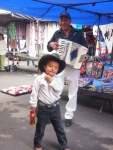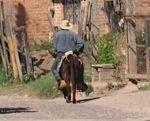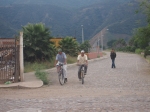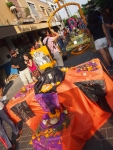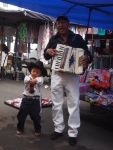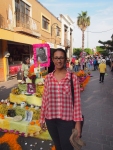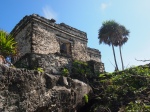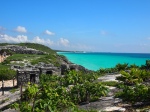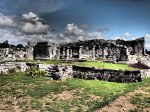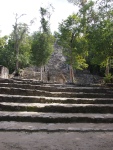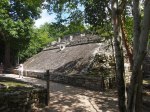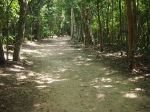Hey here are some pics of a hippo we saw in Guadalajara zoo.
Category Archives: Mexico
Living la vida Mexicana
Mexicans are big on family, public displays of affection (PDAs), food and noise of any kind as long as it’s loud – mariachis, car stereos, annoying whistle things vendors sell in plazas to kids who proceed to use them incessantly, church bells (that seem to go off randomly at any time of day or night in a ‘hey it’s 2am why don’t we ring the church bells’ kind of way) and people who honk their horns for, oh any reason really, and again it doesn’t matter if it’s 3am and people are sleeping. These things and more are all part of the Mexican way of life it seems. They like it fast, they like it loud, and they’re not too concerned whether other people like it or not.
Walk down to a plaza in any Mexican town, at any time of the day or night and chances are you’ll see parents sitting on benches eating street food while the kids are running around the plaza playing with each other, or throwing those weird things that light up in the air or blowing on annoying horns.
You’ll see lovers entwined in passionate embraces and the awkwardness of a first or second date. You’ll see food stalls and you’ll hear music – could be some mariachis, could be a shop front blaring out Mexican music at completely inappropriate levels to apparently ‘attract’ customers. Maybe it’s a pharmacy blasting out techno while someone dressed up as the fat chemist character the chain is known for rave dances out front, or maybe it’s a father playing the according while his son dressed up in the best cowboy suit ever, yells out trying to harmonise with his dad while holding onto a Coke bottle. Whatever it is – crazy, annoying, hilarious – it’s Mexican life.
- Mariachis serenading us at dinner – whether we liked it or not! (For the record, we did.)
- A family hanging out together eating street food in Tlaquepaque’s main square.
- Dancing pharmacist of Farmacia Similares who is usually accompanied by loud techno music. I’m positive this is a sales strategy more Australian pharmacies need to employ!
- Father and son team busking to anyone who’d listen. The little boy was AMAZING, such a little character – he’d give that Honey Boo Boo chick a run for her money
A week in Tlaquepaque
Tlaquepaque is an artisan’s town in Guadalajara. Actually, it’s more like a suburb of Guadalajara that feels like a mini town – sort of like Yarraville or Williamstown in Melbourne. Interestingly, it’s mainly Mexican tourists who visit here. Not many gringos here at all, which was fine by us. Some friends from Melbourne were living in Tlaquepaque and studying Spanish, so that combined with the town’s overwhelming charms fuelled our decision to stay there for the week.
We were lucky enough to find an apartment online for $165 USD/week in the Plaza de Artesanias. It was a massive studio with a separate kitchen and bathroom, tastefully decorated with beautiful Mexican pieces.
The food in Tlaquepaque was amazing, particularly the street food. There was everything from grilled corn on a stick, to baked potatoes with corn, broccoli, cheese and sour cream, to hot dogs (nice ones). And of course there were the usual taco stand offerings of tacos with meat and chicken, gorditas (fried maize bread stuffed with whatever you like), empanadas (fried tortillas filled with whatever you like), and our favourite thing ever – the churro-like (didn’t get its ‘proper’ name but am guessing it’s a churro) dessert we went hunting for most nights. Think freshly deep fried churro cut in half, filled with caramel and then rolled in cinnamon and sugar – oh yes!
We had a brilliant place a couple of doors down selling Tortas Ahogado (literally meat or prawn rolls drowned in a tasty sauce).
The fact that I haven’t put on 5kgs is a miracle!
Wedding in Puerto Vallarta
We hadn’t originally planned to go to Mexico on this trip – but got invited to a friend’s wedding a few months before we left, so decided it would be a great excuse to visit!
We spent 2 months in Mexico before travelling to Puerto Vallarta (PV) for the wedding. I think we both thought the town would be similar to Playa del Carmen – very touristy and perhaps a bit soulless. But we were very wrong!
PV was one of our favourite towns in Mexico – it is touristy but has been a popular destination for much longer than Playa, so it has a lot more character, and has more of a local feel. It’s also much prettier – nice beaches with dramatic mountains running along the coast.
A lot of Americans apparently come here to get married, and so there are quite a few all-inclusive resorts like in Cancun and Playa. But they are stretched out along the coast, so you don’t really notice them if you stay in town.
Our friends got married in an amazing wedding venue/hotel right on the beach – Playa Fiesta. We had drinks and dinner there with the wedding party the night before, and then came back the following day for the wedding. It’s all-inclusive for guests staying there, which means it’s pretty hard to not get really drunk.
We had amazing service from all the staff there – the location and facilities are excellent. Overall it was an incredible wedding – thanks so much Brian and Sarah for inviting us!
Welcome to Mascota
We visited the delightful little town of Mascota en route to Puerta Vallarta. It’s a small town about 2.5 hours from Guadalajara, where streets are cobbled and men still ride around on donkeys because they need to.
It’s definitely not a tourist hub which is part of its charm. Although, that is slowly but surely changing thanks to its prime position on the improved road to Puerta Vallarta.
There’s not much to see in the way of ‘tourist’ sites but there are a couple of small extinct volcanoes close by, a nice lagoon not too far away and some other places that the man at the tourist centre at the town’s entrance will tell you about, after he’s tried to sell you his rompope (an eggnogg-like local alcoholic drink that comes in different flavours – we bought one that’s kind of like Bailey’s).
We hired some bikes and rode to the volcano, so we could climb it. But that proved difficult as Mascota is 1268m above sea level, which meant the ride uphill was challenging on our gear-less bikes but also because there was no discernible path up the volcano. We attempted to climb through a local landowner’s corn fields but it seems that intrepid explorers we are not. However, we did get to meet some lovely locals who agreed to mind our bikes while we attempted the climb and that was pretty great.
But if biking isn’t your thing then it’s a beautiful town to just roam around and explore on foot.
Mascota Life
Wander the streets and see if you can see a man on a donkey, or a cowboy-hatted man riding the streets on horseback . Grab a bite at any of the local restaurants and check out the temple ruins in the middle of town or the park by the river on the outskirts. Or just pop down to the main plaza and do what the locals do, sit and chat or even better just sit and contemplate. I think these guys have got the right idea …
- A man on a donkey
- Some local bike riders
- Andrew enjoying Mascota plaza life
- Mascota locals hanging out in the plaza
- Another Mascota local taking it all in at the plaza
- A couple of Mascota locals taking a nap at the plaza
Day of the Dead in Guadalajara
The month long Playa del Carmen experience is over, and now we’re in Guadalajara, the second biggest city in the country. It’s way over the other side from Playa del Carmen, so we skipped what would probably have been 24 hours in the bus for a much cheaper plane flight.
We arrived during the most important national festival of the year, Dia de los Muertos The Day of the Dead. Well, it’s actually two days, during which Mexicans remember their ancestors by coming together and creating altars with offerings to commemorate loved ones who have passed. It was a traditional festival in the pre-Hispanic Days, but the date got moved thanks to the Spanish who merged the festival with the Catholic All Saints and All Souls Days.
Guadalajara is a great city – and despite having over 4 million people, seems very relaxed and easy to get around – definitely not as chaotic and large as Mexico City. We spent a couple of days here and then moved over to a small town just next to Guadalajara called Tlaquepaque, where friends from Melbourne have been living for the past few months. We loved it because there are hardly any western tourists (mainly Mexican which is interesting) and it’s very small with a lovely vibe, friendly people, great artisans shops and amazing street food – so we decided to rent an apartment and stay for the week.
Here are some Guadalajara photos.
- Our first Torta Ahogado experience in Guadalajara. This dish is famous in Jalisco. Tender pork in a chile/tomato sauce which literally drowns the baguette. They had a prawn version that was pretty amazing too.
- One of dozens of Day of the Dead Statues that lined the main plaza
- Inside Guadalajara Cathedral
- Day of the Dead Altar in Guadalajara Centro HIstorico
- Guadalajara Cathedral
- Plaza Guadalajara at dusk. This was the view from the restaurant where we were enjoying 2 for 1 beers ($1 each) and cocktails ($1.70 each). Amazing!
- Guadalajara Cathedral at dusk
- Our first Toucan spotting – in Parque Agua Azul
- Gorditos in a street market near Parque Agua Azul
- Father and son buskers in street market near Parque Agua Azul
- Street altar in Tlaquepaque and me obscuring part of it
The genius of Telehit
Telehit, the Spanish language music video channel, is genius. It’s the one reliable channel you seem to get no matter what cable network your hostel/hotel is connected to. And it’s reliably up beat and entertaining all the time.
Why? Because there’s only really 3 types of videos on Telehit.
1) Eurovision sounding songs by mainly older (by music industry standards) Spanish speaking pop stars (roughly 50% of all videos). All of these videos must contain very overt sexual references and scantily clad female singer. Strangely it’s OK to be be an older pop star in the Spanish-speaking world, as long as you’re willing to get your gear off.
2) Standard pop songs by young stars or girl/boy bands (30%) . All of these videos contain happy images of young people smiling, dancing, frolicking on beaches. Who wouldn’t want to be in the video below? If these artists survive in the industry, no doubt they’ll have to start getting their gear off more.
3) Slightly obscure indie/hipster type songs (the last 5%).
Eating out in Playa del Carmen
There are heaps of restaurants in Playa – most are centred around the tourist strip (5th avenue), and all market themselves pretty aggressively to get you in there. Here are the places in town that stood out for us – both good and bad.
The good
Skinny Bikini Potatoes – Calle 20 between 5th and 10th Avenue
Excellent food – great service and great drinks specials. Live DJ some nights. Highly recommended.
El Jurador – Constituents between 25 and 30, across road from Mega
Excellent fish and shrimp tacos (19 pesos each!), great milkshakes, good priced beers, excellent ceviches. A great inexpensive option – our favourite place in Playa!
Ambasciate D’Italia, on corner of 5th Avenueand 24
This is definitely the best Italian we’ve had in Playa. Excellent fresh pasta – great service and great value. If you dine before 7pm the deal is even better. Highly recommended.
Taqueria Arandas, Corner 10th avenue and Calle 16
Excellent cheap (13 pesos each) meat based tacos (including beef tongue and other delicacies). Doesn’t open until 7pm but stays open till late. Not recommended for vegetarians though.
100% Natural
An excellent chain you’ll find around Mexico (Oaxaca, Mexico City etc) – this is always reliably good. It’s one of the few places that serves fresh and healthy food options. They actually have things like salads and vegetables! Sometimes hard to come by in Mexico. Highly recommended.
Kaxapa Factory, Av Constituyentes, betwen 10 and 15 avenues
Great inexpensive Venezuelan food and friendly service. Most of their food is gluten free and they have great vegetarian and vegan options.
The bad
Lucky Luciano (5th avenue corner Calle 28)
Famous for their pizzas (which admittedly we didn’t try) but in terms of pasta they got a big fail. My pasta was made with 2 minute noodles – they even seemed to use the packet flavouring – which was then bizarrely mixed with very nice fresh vegetables. They clearly don’t know how to make pasta. And it was expensive.
Babes (Calle 10 between 5th and 10th)
A Lonely Planet and Trip Advisor favourite, this was a big disappointment. The entre was sensation al(seafood rolls) but the two mains were both terrible. Both used great fresh ingredients, but were drenched in a sickly sweet sauce. This is Thai food for people who’ve never eaten proper Thai food, and who love their meals very sweet.
Mayan ruins of Coba and Tulum
Coba and Tulum are two fantastic Mayan ruins nearby to Playa del Carmen – below are some photos from both.
Tulum gets a lot of tourists because it’s so close to Playa and Cancun (and has a beautiful beach) – whereas Coba is a bit further away, and a bit quieter (if you arrive before or after the tour groups do). Coba is also a much larger site – there’s about 6km of walking needed to access all the ruins. If you’re not up to walking, you can hire a bicycle (35MXD) or get someone else to drive you around in a cyclo/bicycle-taxi (140MXD normally but 70MXD in the low season).
These sites are both worth checking out!
- Tulum is a Pre-Columbian Maya walled city which served as a major port for Cobá. Tulum was one of the last cities inhabited and built by the Mayans, and was at its height between the 13th and 15th centuries.
- The beautiful Carribbean by the Tulum ruins
- Central ruins in Tulum
- La Iglesia at Coba
- A ball court in Coba
- The Nohoch Mul pyramid, the tallest in the Yucatan at 42 metres
- View from the top of the Nohoch Mul pyramid (42m high)
- A series of stone and plaster roads run from central Coba to various smaller sites in the area. These are known by the Maya term sacbe – the longest is over 100 kilometres.
Is Mexico really that dangerous?
People love telling you how unsafe Mexico is, particularly Mexico City, which is often quoted as being one of the most “dangerous cities in the world”. I’m glad because going to “dangerous” places is an important part of building up your traveller kudos, and impressing friends when you’re back home. (As an aside, as well as facing “danger”, you can get traveller kudos by doing things like :1) getting drunk with a local, 2) remembering the names of any local beers you’ve tried and claiming they’re the best you’ve ever had (provided that beer is not sold in your home country), 3) Remembering the name of some obscure town where you once ate a taco so you can relate the story when eating at a Mexican restaurant with your friends back home…. “This taco is OK, but it’s nothing like the taco I had in this little local market in (insert name of town here)”).
But back to the topic.
It’s inevitable there would be a lot of crime in a city of more than 20 million people, but how violent or dangerous is Mexico overall?
There’s no denying a lot of recent violence has come from the government’s ill-fated drug war, which is said to have claimed 50,000 lives since 2006.
But even taking the drug war into account, Mexico is still far from being the most violent country in Latin America – it ranked 10th in a 2008 study (Latinobarimetro Annual Report).
Certainly as a tourist, Mexico seems very safe. That could be because if a crime is committed against a tourist, the police may actually do something about it (most crimes against Mexicans are either not reported or not investigated). And also because as tourists we tend to stay in nice area and avoid travelling to the areas renowned for drug violence (ie. the northern border areas).
But there are still obviously a lot of crimes being committed against the average Mexican – nearly a third of households suffered a crime in 2011. That’s a pretty staggering statistic, even more significant when you consider that and only in 8% of those cases was a police investigation opened.
As Jorge G Castaneda points out in his excellent book, Manana Forever, the two traits Mexico is most commonly associated with are corruption and lawlessness. And rightfully he sees them as significant blocks to the country’s development.
Law and order in Mexico – some facts
- People don’t trust the police – a 2010 poll found that only 8% of respondents felt strong confidence in the police.
- There is no consistent criminal code across the country – 93% of crimes are non-federal (ie. they fall into the differing laws of the 32 states). Given most crimes are unreported, Castaneda suggests there’s a link between the two.
- There are 6 different types of police – all have different authority – some are judicial, some preventative. All are considered ineffective and corrupt*
- Despite being a major transit and drug producing country, drug use in Mexico is very low in comparison to both wealthy nations and the rest of Latin America.
- According to some estimates, more than half of country’s economic activity takes place underground. More people work in the informal economy than in the tourist industry (the country largest employer).
- Mexicans don’t like paying tax – Mexico has the lowest tax take of any country in the OECD.
So law and order is definitely an issue for Mexicans. And it’s clearly a very dangerous place if you’re involved in law enforcement, the drug trade or the military. I imagine it’s not very safe if you’re an honest politician either.
But it’s definitely safe in our tourist bubble…
Footnote
* The are 6 or 7 types of police in Mexico (Federal, State, Municipal, Traffic, Metro, Tourist and one other?) – all are quite ineffective, due to widespread corruption and a general disregard for the rule of law. (This is part of the reason why the military was called in to fight the “war on drugs”). The police are split into judicial and preventative – judicial police are supposed to investigate crimes, and preventive police are supposed to prevent crimes (by driving around cities with their siren lights on – something you see all over Mexico). In Mexico City, in the tourist zone, we saw patrols going up and down most streets every few minutes – the largest police presence I have seen anywhere in my travels.











